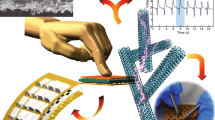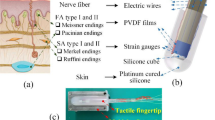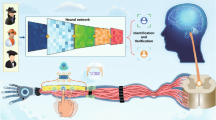Abstract
Wearable human–machine interface (HMI) is an advanced technology that has a wide range of applications from robotics to augmented/virtual reality (AR/VR). In this study, an optically driven wearable human-interactive smart textile is proposed by integrating a polydimethylsiloxane (PDMS) patch embedded with optical micro/nanofibers (MNF) array with a piece of textiles. Enabled by the highly sensitive pressure dependent bending loss of MNF, the smart textile shows high sensitivity (65.5 kPa−1) and fast response (25 ms) for touch sensing. Benefiting from the warp and weft structure of the textile, the optical smart textile can feel slight finger slip along the MNF. Furthermore, machine learning is utilized to classify the touch manners, achieving a recognition accuracy as high as 98.1%. As a proof-of-concept, a remote-control robotic hand and a smart interactive doll are demonstrated based on the optical smart textile. This optical smart textile represents an ideal HMI for AR/VR and robotics applications.
Graphical abstract





Similar content being viewed by others
References
Lim S, Son D, Kim J, Lee YB, Song J-K, Choi S, Lee DJ, Kim JH, Lee M, Hyeon T, Kim D-H. Transparent and stretchable interactive human machine interface based on patterned graphene heterostructures. Adv Funct Mater 2015;25:375.
Wang J, Lin M-F, Park S, Lee PS. Deformable conductors for human–machine interface. Mater Today 2018;21:508.
Chen J, Zhu G, Yang J, Jing Q, Bai P, Yang W, Qi X, Su Y, Wang ZL. Personalized keystroke dynamics for self-powered human-machine interfacing. ACS Nano 2015;9:105.
Yi J, Dong K, Shen S, Jiang Y, Peng X, Ye C, Wang ZL. Fully fabric‑based triboelectric nanogenerators as self‑powered human–machine interactive keyboards. Nanomicro Lett 2021;13:103.
Weng W, Yang J, Zhang Y, Li Y, Yang S, Zhu L, Zhu M. A route toward smart system integration: from fiber design to device construction. Adv Mater 2020;32:e1902301.
Loke G, Khudiyev T, Wang B, Fu S, Payra S, Shaoul Y, Fung J, Chatziveroglou I, Chou PW, Chinn I, Yan W, Gitelson-Kahn A, Joannopoulos J, Fink Y. Digital electronics in fibres enable fabric-based machine-learning inference. Nat Commun 2021;12:3317.
Lee GH, Park JK, Byun J, Yang JC, Kwon SY, Kim C, Jang C, Sim JY, Yook JG, Park S. Parallel signal processing of a wireless pressure-sensing platform combined with machine-learning-based cognition, inspired by the human somatosensory system. Adv Mater 2020;32:e1906269.
Xiong Y, Shen Y, Tian L, Hu Y, Zhu P, Sun R, Wong C-P. A flexible, ultra-highly sensitive and stable capacitive pressure sensor with convex microarrays for motion and health monitoring. Nano Energy 2020;70:104436.
Choi S, Yoon K, Lee S, Lee HJ, Lee J, Kim DW, Kim MS, Lee T, Pang C. Conductive hierarchical hairy fibers for highly sensitive, stretchable, and water-resistant multimodal gesture-distinguishable sensor VR applications. Adv Funct Mater 2019;29:1905808.
Pan L, Chortos A, Yu G, Wang Y, Isaacson S, Allen R, Shi Y, Dauskardt R, Bao Z. An ultra-sensitive resistive pressure sensor based on hollow-sphere microstructure induced elasticity in conducting polymer film. Nat Commun 2014;5:3002.
Zhong J, Ma Y, Song Y, Zhong Q, Chu Y, Karakurt I, Bogy DB, Lin L. A flexible piezoelectret actuator/sensor patch for mechanical human−machine interfaces. ACS Nano 2019;13:7107.
Pu X, Guo H, Chen J, Wang X, Xi Y, Hu C, Wang ZL. Eye motion triggered self-powered mechnosensational communication system using triboelectric nanogenerator. Sci Adv 2017;3:e1700694.
Zhu G, Yang WQ, Zhang T, Jing Q, Chen J, Zhou YS, Bai P, Wang ZL. Self-powered, ultrasensitive, flexible tactile sensors based on contact electrification. Nano Lett 2014;14:3208.
Persano L, Dagdeviren C, Su Y, Zhang Y, Girardo S, Pisignano D, Huang Y, Rogers JA. High performance piezoelectric devices based on aligned arrays of nanofibers of poly(vinylidenefluoride-co-trifluoroethylene). Nat Commun 2013;4:1633.
Zhao H, O’Brien K, Li S, Shepherd RF. Optoelectronically innervated soft prosthetic hand via stretchable optical waveguides. Sci Robot 2016;1:eaai7529.
Guo J, Niu M, Yang C. Highly flexible and stretchable optical strain sensing for human motion detection. Optica 2017;4:1285.
Shi X, Zuo Y, Zhai P, Shen J, Yang Y, Gao Z, Liao M, Wu J, Wang J, Xu X, Tong Q, Zhang B, Wang B, Sun X, Zhang L, Pei Q, Jin D, Chen P, Peng H. Large-area display textiles integrated with functional systems. Nature 2021;591:240.
Ma Y, Ouyang J, Raza T, Li P, Jian A, Li Z, Liu H, Chen M, Zhang X, Qu L, Tian M, Tao G. Flexible all-textile dual tactile-tension sensors for monitoring athletic motion during taekwondo. Nano Energy 2021;85:105941.
Yan W, Dong C, Xiang Y, Jiang S, Leber A, Loke G, Xu W, Hou C, Zhou S, Chen M, Hu R, Shum PP, Wei L, Jia X, Sorin F, Tao X, Tao G. Thermally drawn advanced functional fibers: new frontier of flexible electronics. Mater Today 2020;35:168.
Zhu C, Li R, Chen X, Chalmers E, Liu X, Wang Y, Xu BB, Liu X. Ultraelastic Yarns from curcumin-assisted ELD toward wearable human-machine interface textiles. Adv Sci 2020;7:2002009.
Cao R, Pu X, Du X, Yang W, Wang J, Guo H, Zhao S, Yuan Z, Zhang C, Li C, Wang ZL. Screen-printed washable electronic textiles as self-powered touch/gesture tribo-sensor for intelligent human-machine interaction. ACS Nano 2018;12:5190.
Wu R, Ma L, Patil A, Hou C, Zhu S, Fan X, Lin H, Yu W, Guo W, Liu XY. All-textile electronic skin enabled by highly elastic spacer fabric and conductive fibers. ACS Appl Mater Interfaces 2019;11:33336.
Lin X, Wu M, Zhang L, Wang D. Superior stretchable conductors by electroless plating copper on knitted fabrics. ACS Appl Electron Mater 2019;1:397.
Karim N, Afroj S, Tan S, He P, Fernando A, Carr C, Novoselov KS. Scalable production of graphene-based wearable e-textiles. ACS Nano 2017;11:12266.
Li Jh, Chen Jh, Xu F. Sensitive and wearable optical microfiber sensor for human health monitoring. Adv Mater Technol 2018;3:1800296.
Zhang L, Pan J, Zhang Z, Wu H, Yao N, Cai D, Xu Y, Zhang J, Sun G, Wang L, Geng W, Jin W, Fang W, Di D, Tong L. Ultrasensitive skin-like wearable optical sensors based on glass micro/nanofibers. Opto-Electron Adv 2020;3:19002201.
Pan J, Zhang Z, Jiang C, Zhang L, Tong L. A multifunctional skin-like wearable optical sensor based on an optical micro-/nanofiber. Nanoscale 2020;12:17538.
Tang Y, Liu H, Pan J, Zhang Z, Xu Y, Yao N, Zhang L, Tong L. Optical micro/nanofiber-enabled compact tactile sensor for hardness discrimination. ACS Appl Mater Interfaces 2021;13:4560.
Zhu HT, Zhan LW, Dai Q, Xu B, Chen Y, Lu YQ, Xu F. Self-assembled wavy optical microfiber for stretchable wearable sensor. Adv Optical Mater 2021;9:2002206.
Brambilla G, Payne DN. The ultimate strength of glass silica nanowires. Nano Lett 2019;9:831.
Tong L, Gattass R, Ashcom J, He S, Lou J, Shen M, Maxwell I, Mazur E. Subwavelength-diameter silica wires for low-loss optical wave guiding. Nature 2003;426:816.
Yao N, Linghu S, Xu Y, Zhu R, Zhou N, Gu F, Zhang L, Fang W, Ding W, Tong L. Ultra-long subwavelength micro/nanofibers with low loss. IEEE Photon Technol Lett 2020;32:1069.
Kang Y, Gong J, Xu Y, Yao N, Fang W, Guo X, Tong L. Ultrahigh-precision diameter control of nanofiber using direct mode cutoff feedback. IEEE Photon Technol Lett 2020;32:219.
Sirbuly DJ, Tao A, Law M, Fan R, Yang P. Multifunctional nanowire evanescent wave optical sensors. Adv Mater 2007;19:61.
Dellon ES, Keller K, Moratz V, Dellon AL. The relationships between skin hardness, pressure perception and two-point discrimination in the fingertip. Hand Surg 1995;20:44.
Wu C, Ding W, Liu R, Wang J, Wang AC, Wang J, Li S, Zi Y, Wang ZL. Keystroke dynamics enabled authentication and identification using triboelectric nanogenerator array. Mater Today 2018;21:216.
Jin T, Sun Z, Li L, Zhang Q, Zhu M, Zhang Z, Yuan G, Chen T, Tian Y, Hou X, Lee C. Triboelectric nanogenerator sensors for soft robotics aiming at digital twin applications. Nat Commun 2020;11:5381.
Wen F, Sun Z, He T, Shi Q, Zhu M, Zhang Z, Li L, Zhang T, Lee C. Machine learning glove using self-powered conductive superhydrophobic triboelectric textile for gesture recognition in VR/AR applications. Adv Sci 2020;9:2000261.
Li G, Liu S, Wang L, Zhu R. Skin-inspired quadruple tactile sensors integrated on a robot hand enable object recognition. Sci Robot 2020; 5:eabc8134.
Zhu M, Sun Z, Zhang Z, Shi Q, He T, Liu H, Chen T, Lee C. Haptic-feedback smart glove as a creative human-machine interface (HMI) for virtual/augmented reality applications. Sci Adv 2020;6:eaaz8693.
Acknowledgements
We acknowledge funding from the National Natural Science Foundation of China (No. 61975173), Major Scientific Research Project of Zhejiang Lab (No. 2019MC0AD01), and Key Research and Development Project of Zhejiang Province (No. 2021C05003), the CIE-Tencent Robotics X Rhino-Bird Focused Research Program (No. 2020-01-006).
Author information
Authors and Affiliations
Corresponding authors
Ethics declarations
Conflict of interest
The authors declare no competing financial interest.
Additional information
Publisher's Note
Springer Nature remains neutral with regard to jurisdictional claims in published maps and institutional affiliations.
Supplementary Information
Below is the link to the electronic supplementary material.
Supplementary file1 (MP4 7678 kb)
Supplementary file2 (MP4 12765 kb)
Rights and permissions
About this article
Cite this article
Ma, S., Wang, X., Li, P. et al. Optical Micro/Nano Fibers Enabled Smart Textiles for Human–Machine Interface. Adv. Fiber Mater. 4, 1108–1117 (2022). https://doi.org/10.1007/s42765-022-00163-6
Received:
Accepted:
Published:
Issue Date:
DOI: https://doi.org/10.1007/s42765-022-00163-6




